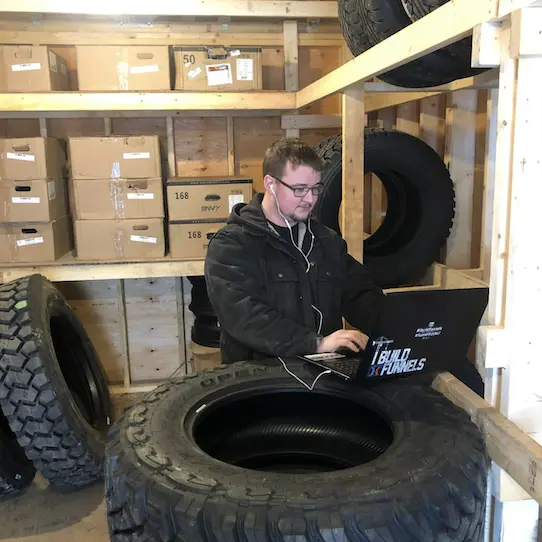
Michael Dallas-Petersen is an internet marketer based outta British Columbia, Canada. Married, two kids. Tried just about every way imaginable to make money online: travel agency, affiliate marketing, ecom, SMMA—nothing stuck. A year went by. His young family needed him to come through. Eventually, he starts up a tire shop, of all things. He did the marketing, built out the systems, the standard operating procedures, and it takes off. Did like a quarter-million in sales in the first few months.
Once he did that, he realized: Damn, I’m kinda good at this. Getting a business going, handling the nitty-gritty. Doing the stuff most people find boring. Once his biz buddies got wind of his success, they started asking him for help. Mike agreed. Coupla months later, he was making enough to where he and his wife could stay home with the kiddos full-time. A few months after that, he was hitting consistent $10k months. Sold the tire shop and doubled down on this.
“Since then,” Mike says, “I’ve been helping business owners from all over the world build their marketing and sales systems. And I’ve never had to run ads, never had to build elaborate campaigns. I’ve done marketing, sure, but I’ve never had to do anything crazy elaborate that you hear of like with other internet business models. I’m definitely not one of those Lambo people, who was homeless, you know, and found a penny and traded it up and turned it into millions and millions of dollars.”
Mike’s just your average dude, making good money from his laptop. He considers himself a remote integrator, a term popularized by (cough, cough) scammer Ravi Abuvala. So far, Mike seems like the exact opposite of Ravi, so that’s good. But he’s boiled his process down into five basic steps. First and foremost, you’ve gotta get the word out about what you can do for these business owners. You can do this through Facebook, Instagram, YouTube, LinkedIn, email, word of mouth, you name it. The key is, don’t stop. Do a little outreach every day.

Second, once you’ve found a potential client, you’re gonna wanna begin the discovery phase. Interview ’em. What’s going on in their business? Where can you save ’em some time, some money? What are their biggest pain points? Step three is the proposal stage. You’re gonna put together the smartest offer you can based on the intel you just gathered, structure it in a way to where they basically can’t say no, and then negotiate what you’ll be paid for the services you’ll be providing for them.
Step four, once you’ve got a client, is the build phase. Mike’s favorite part. “I’m a night owl,” he says. “Kids go to bed at 7:30, and I just build. I’m just in my zombie mode, I get going, and then the following day I can sleep in or help get my kids to school or whatever I want. But I just love the build phase. This is where I have most of my fun. You take your plan and you build it. It comes to life. You’re the architect of solving this person’s pain. You’ll hit some roadblocks. That’s okay. You’ll have me and an entire community to support you.”
The fifth and final step is to systematize and automate and delegate and become progressively pickier in who you work with. This way, you can make more and more while working less. If you’d like Mike’s help mastering all five steps, apply for his coaching program, The Integrator Academy, today. No mention of cost—I’m sure it’s expensive—but I liked everything I heard. I guess it goes without saying, but you’d have to be pretty well-rounded (in terms of your skill set) in order to do this.